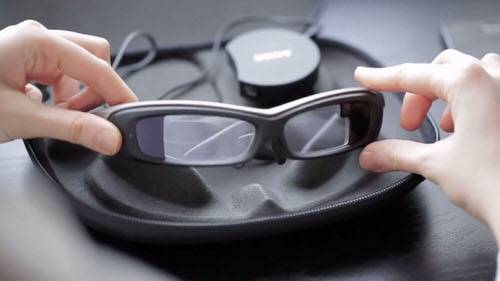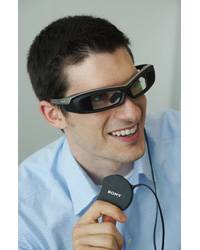
Today, Sony announced that the developer edition of its augmented reality headset, the SmartEyeglass, is available for pre-order ahead of a planned March release in 10 countries. Although it bears some similarities to an earlier ill-fated wearable, the SmartEyeglass is no Google Glass.
It’s much, much worse.
See also: Google Glass Moves On From Google X, Lands In Tony Fadell’s Shop
The SmartEyeglass headset, slated for a 2016 consumer release, is basically Sony’s effort to exploit the vacuum left by Google’s temporary retreat on Glass, which is being retooled under Nest CEO Tony Fadell. But even with little competition, SmartEyeglass looks like a flop waiting to happen, mainly because Sony’s engineers learned the wrong lessons from Google Glass’s failures as a consumer device.
Spec This Out
The SmartEyeglass device offers an augmented reality display across both lenses, meaning users will be treated to a clearer, more comfortable interface than they might have had with Glass’s single lens display area. The headset is connected to a wired controller module that acts as the SmartEyeglass’s battery, speaker, microphone, and touch interface.
Sony’s promotional video lays it out:
https://www.youtube.com/watch?v=Bx7O_h09HKA
While SmartEyeglass seems to improve on a number of Glass’s problems—like the aforementioned limited display, as well as its touchy touch interface—it doubles down on one of Glass’s worst failings. The thing is ugly as sin. When it comes to wearable tech, it doesn’t matter how well a gadget works; if no one wants to wear it because people point and laugh in the streets, it’s destined for the desk drawer.
Moreover, none of the functions Sony shows off in its demo video are particularly revolutionary or interesting—they’re merely a shoddy repackaging of capabilities other devices already have.
Want turn-by-turn navigation without looking at your smartphone? Any Android Wear smartwatch does this already, whether it has a GPS sensor built in or not. What about speech-to-text instant-messaging? Android Wear gets this job done, too.
And if you’re dying to send a photo to a friend, you’re probably going to be better off using the camera on your phone, since the one packed into the SmartEyeglass device is a measly three megapixels. (Even Glass managed five.) Meanwhile, Sony says that the device’s battery only lasts a little over two hours, and that’s without using the camera. Glass, by contrast, managed about a day’s worth of battery life.
Developers Beware

Part of Sony’s current push with the SmartEyeglass is to entice developers to create as many apps as possible prior to a consumer-grade release next year. Additionally, Sony seems to acknowledge that the device may be best suited to use at big companies, citing a demonstration from APX Labs at CES last month. APX showed how the SmartEyeglass could be used to instruct warehouse workers about what boxes to move where, or to give augmented reality assistance to mechanics rebuilding an engine.
See also: They’re No Google Glass, But These Epson Specs Offer A New Look At Smart Eyewear
Even with those uses in mind, the SmartEyeglass headset seems destined for failure. Warehouse workers probably wouldn’t relish wearing a goofy headset with a wire snaking down to the control module—ditto for any mechanics getting their hands dirty.
Unless Sony gives the SmartEyeglass a major design overhaul (and maybe a new, less terrible name), don’t be surprised if this headset fails to make it onto anyone’s face.
In case you actually are interested in checking out SmartEyeglass, here’s how. Developers in the United Kingdom and Germany can place an order for €670 or £520, respectively, while at some point in the near future the facewear will also be available in the United States and Japan for $840 or ¥100,000. Business customers in France, Italy, Spain, Belgium, Netherlands and Sweden will be able to buy the device once it’s released next month.
Images courtesy of Sony









